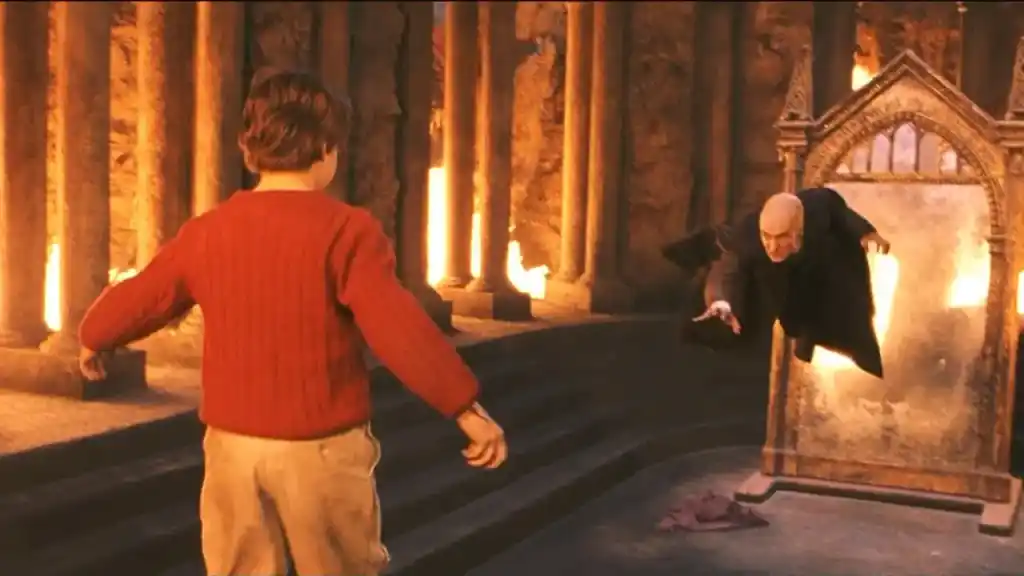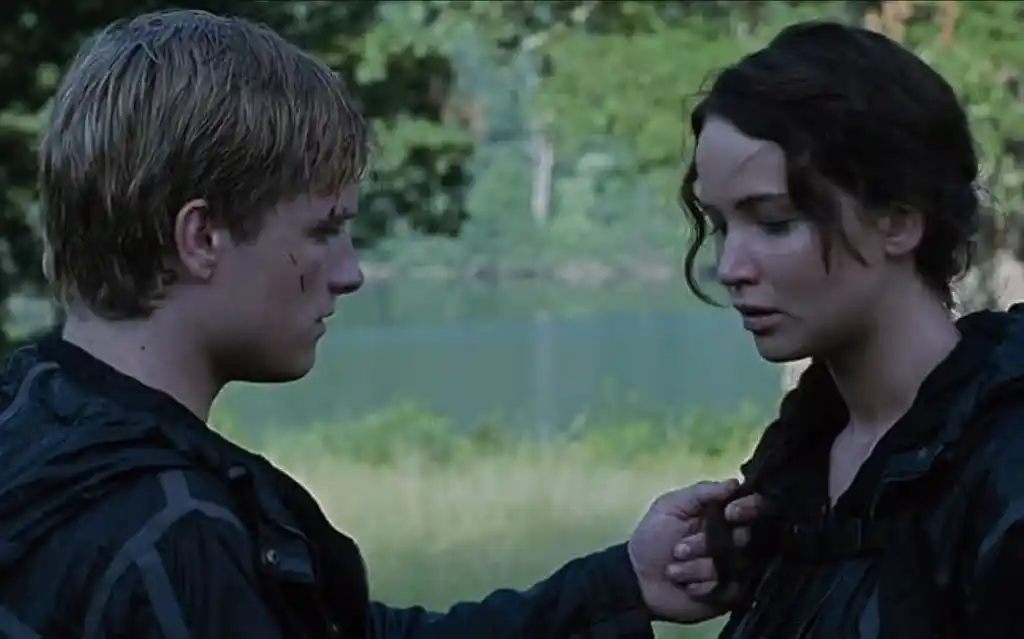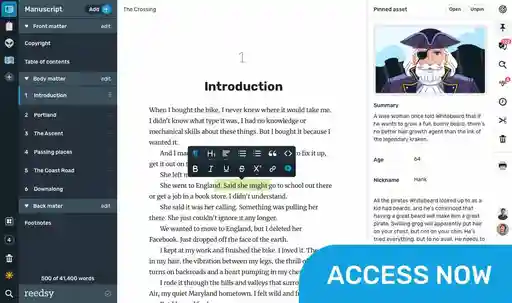Guides • Perfecting your Craft
Last updated on Oct 15, 2025
Climax of a Story: Definition, Examples, and Tips
Martin Cavannagh
Head of Content at Reedsy, Martin has spent over eight years helping writers turn their ambitions into reality. As a voice in the indie publishing space, he has written for a number of outlets and spoken at conferences, including the 2024 Writers Summit at the London Book Fair.
View profile →When done right, the climax of your story is what ensures that a reader will finish your book breathless and desperate to share it with their friends. In this guide, we'll show you five common types of climaxes with tips and examples to help you bring your own narrative to a mighty crescendo.
What is the climax of a story?
The climax of a story is its biggest turning point, occurring when narrative tension is at an all-time high. It typically follows a series of escalating events (known as rising action) that are caused by an inciting incident.
The climax pushes the protagonist to confront their greatest challenge and/or make a crucial decision — bringing the central conflict to close (or nearly to a close). This should lead to a resolution that offers readers some kind of emotional satisfaction.
Q: At what point in a traditional story arc should the climax typically occur?
Suggested answer
The climax should be near the end of the story. Everything in the story before this point should be building toward this climax.
Melody is available to hire on Reedsy ⏺
To elaborate on Melody’s answer above, this crucial story beat usually takes place around 75-95% of the way through a story. The climax will often see the protagonist on the cusp between failure and success, and push them over the edge (one way or the other).
That said, it’s important to remember that a climax can look different in different types of stories. Sometimes it’s explosive and theatrical; other times it’s subtler, but clearly course-altering nonetheless. While not every climax needs to be all car chases and dynamite, it should always be recognizable to readers as the climax.
Let’s take a look at five common types of climaxes to better grasp how each one works. (Big spoilers ahead for the accompanying climax examples!)
5 types of climaxes — with examples
The Hero’s Climax
You may have heard of The Hero’s Journey and the Three Act Structure — two narrative models that prescribe (or encourage) writers to plot their stories in a certain way. In both of these, the climactic moment is the final hurdle for the protagonist to overcome: the fight at the end of the movie, the closing statements in a courtroom drama, or even a big romantic gesture from a protagonist who’s grown out of his emotionally stunted ways.
This is what we call the Hero’s Climax. The power of this climax comes from the empathetic journey we’ve come on with the main character: we know what they’re fighting for, and what’s at stake if they don’t win. By the time we arrive at the climax, we know that our hero must overcome the final challenge to succeed… and what the consequences will be if they do not.
🦸 Hero’s Climax Example: Harry Potter and the Sorcerer's Stone

The first book in J.K. Rowling’s magical series introduces us to a young Harry Potter, who discovers that he is a wizard and is whisked away to Hogwarts School of Witchcraft and Wizardry. There, he makes new friends, uncovers the truth about his past, and begins to understand the threat of the Dark Lord Voldemort's possible return.
Over the course of the novel, Harry and his friends learn about a mysterious artifact called the Sorcerer’s Stone, rumored to grant everlasting life. In the Hero’s Climax of the story, Harry must face Voldemort and prevent him from acquiring the stone. Harry manages to do so through a combination of bravery and moral clarity, and vanquishes Voldemort.
This Hero’s Climax works so well because a) it’s a stark, dramatic face-off between the hero and his greatest nemesis, and b) it shows how Harry’s courage, morality, and selflessness have grown over the book. Not only is his external conflict with Voldemort resolved, but also his internal conflict about who he is and whether he truly belongs in the Wizarding World.
In other words, Harry has proven himself worthy and triumphed — making this a true Hero’s Climax.
The Action Climax
Speaking of dramatic face-offs, let’s get into our next type of climax: the Action Climax. This one is exactly what it sounds like — main characters squaring off in a high-stakes, adrenaline-fueled showdown. An Action Climax is defined by physical confrontation, where the characters’ strength, skills, and determination are pushed to their limits.
As you might expect, it often overlaps with the Hero’s Climax (and our example directly below is actually both!). But unlike the Hero’s Climax, it can involve multiple characters rather than just one key protagonist, and it must be action-packed. A Hero’s Climax, by contrast, has just one central “hero” and can be as “undramatic” as the protagonist deciding to open a bakery with their best friend (though who knows what rich emotional tensions that would bring!).
On that note, don’t forget that a compelling Action Climax isn’t just about the physical conflict — it’s also about emotional payoff. This is the moment when your characters must confront their flaws, fears, or mistakes in order to succeed… under highly pressurized circumstances.
💥 Action Climax Example: The Terminator
Nothing more action-packed than someone trying to save the world. In this example, the world-saver in question is Kyle Reese — a soldier from a dystopian future who’s traveled back in time. His mission: protect Sarah Connor, an innocent woman, from a killer cyborg known as the Terminator.
Reese’s mission grows even more urgent when it's revealed that Connor will birth the future resistance’s leader. It becomes yet more urgent when Reese falls in love with her… and discovers that he is the father of her future child. (Cue audience gasp!)
The Terminator’s climax takes place in an eerie, ominous robot factory where Reese and Connor fight for their lives — and that of their future son. Reese eventually plants a pipe bomb in the Terminator, but doesn’t have enough time to get away… and so sacrifices himself to destroy the robot and save humanity.
By the time we reach this moment, Reese’s sacrifice has exponentially more impact than it would have at the start of the movie. Essentially, the personal and geopolitical stakes at play come together for a perfectly calibrated Action Climax.
Q: How can authors effectively build tension leading up to the climax?
Suggested answer
Well, the main method is to up the stakes as you go along. The more it matters emotionally to the characters and externally to their circumstances and the world around them, the more important that climax becomes. Every time you increase the stakes, the anticipation of readers goes up surrounding the climax and what might result. The final confrontation between hero(es) and villain becomes and edge-of-the-seat affair.
If you struggle with this, the technique I recommend is to examine the plot questions asked and answered. All plots are effectively a series of questions asked and answered. When you ask and how soon you answer is part of building tensions. Some questions carry over several scenes, some are answered right away. Some last whole chapters or several chapters. Some are asked at the beginning and not answered until the end, like the main driving core quest question of will good conquer evil? Will the protagonist get what he or she wants or needs? Will the villain prevail?
Make sure you are answering the questions you ask in appropriate places. Yes, you may want to set up a sequel and leave a few things hanging but the trick is to pick the right questions. The rest need to be answered, and figuring out which questions depend upon that climax and asking more and more of them as you lead up to it is a really great way to increase suspense and anticipation and lend that sense of urgency to the climax that keeps readers turning pages and dying to know what happens.
Bryan thomas is available to hire on Reedsy ⏺
Stakes need to be continually raised as the story builds to a climax. The problem[s] should be getting more and more difficult until the climax is reached.
Melody is available to hire on Reedsy ⏺
Subtle foreshadowing is a solid way to build tension. Hinting at what's to come can prime the reader for the climax without revealing exactly what's coming—just that something is coming.
Well-written, lower-level conflicts between characters is another effective tool to build tension: short arguments, occasional emotional blow-ups, etc. These are, in effect, a kind of foreshadowing themselves, setting the reader up for the finale, whatever it may be.
Brett is available to hire on Reedsy ⏺
The Tragic Climax
Brace yourself for disaster — next up is the Tragic Climax. While most contemporary climaxes take place near the close of a story, that wasn’t always the standard. In many classic tragedies, like Macbeth and Hamlet, the climax occurs at the story’s midpoint… leaving plenty of time for things to go very wrong in the aftermath.
This structure is so common in theatrical tragedies that German writer Gustav Freytag came up with a name for it: Freytag’s Pyramid. As you’d expect, this involves the first half of the plot building up to a point of no return — a climax that sees the hero do something unforgivable, causing their life to spin out of control in the back half of the story.
In Macbeth, this climax is the murder of King Duncan; in Hamlet, it’s the (accidental) murder of Polonius. See where we’re going with this? Check out the example below for yet another perfectly executed (no pun intended!) Tragic Climax.
💔 Tragic Climax Example: Antigone
In Sophocles’s sequel-of-sorts to Oedipus Rex, our tragic hero is Creon, the newly ascended King of Thebes. When his niece, Antigone, defies his edict and gives a proper burial to her brother — who has been branded a villain — Creon is torn. Should he put Antigone to death, despite pleas from his wife, son, and beloved niece? Or should he defy his own edict, potentially undermining his authority as king?
At the Tragic Climax of Antigone, Creon is given every reason not to execute Antigone, but his stubborn devotion to “following through” proves to be his fatal flaw. After her death, Creon’s son, who was engaged to Antigone (yes, they were cousins — it was ancient Greece!), kills himself out of sorrow. Creon’s wife then kills herself from the grief of losing her son.
The end of the play sees Creon still in power, but only after losing everything that truly mattered to him. Things have — to say the least — taken a turn for the worse.
The Surprise Climax
Readers and audiences today are pretty sophisticated. By the time they reach adulthood, they’ve read and seen thousands of stories play out before their eyes, many of which will share certain structural and narrative traits.
As a result, most readers know intuitively that a story's climax results from all the plot points that came before it. If Rocky spends the bulk of his movie training to fight Apollo Creed, it doesn’t take a huge leap to predict the climax will take place in a boxing ring.
However, some stories will (largely) play into these expectations… only to pull the rug out from under readers, allowing the climax to serve as a “big reveal.” That’s a Surprise Climax!
🤯 Surprise Climax Example: The Sixth Sense
Child psychologist Malcolm Crowe begins working with nine-year-old Cole, who claims to “see dead people” in the form of ghosts. With encouragement from Crowe — who failed to help a similar client in the past — Cole helps ghosts resolve their unfinished business and pass on.
The audience believes this is building to a climax in which Crowe helps Cole come to terms with his abilities and be less afraid. Indeed, in a powerful moment, Cole helps the ghost of a young girl reveal that her stepmother poisoned her… and prevent the same fate from befalling her younger sister.
However, in the Surprise Climax, Crowe realizes that he himself is dead and has been a ghost the entire time. What we all believed to be a journey of professional redemption is now revealed to be a story about a ghost resolving unfinished business. (Yes, it’s a famous twist that pretty much everyone knows at this point — but at the time, it was revolutionary storytelling!)
This twist also makes for an excellent climax precisely because it doesn’t undermine the main narrative. Instead, it’s amplified by how closely it relates to the A-story — and by the tiny clues embedded in the script. (We’ll talk more about this in the “Tips” section below.)
A professional editor can help craft your climax
Rosie W.
Available to hire
A conscientious and enthusiastic indexer, my subject specialisms are Geography, Environmental/Earth Science, Social Science and Economics.
Erin C.
Available to hire
Former literary agent with 15+ years of experience, specializing in developmental & copy edits for MG, YA, horror, mystery, & magic realism
Brett S.
Available to hire
Multi-award-winning horror/fantasy/science fiction editor with 28+ years experience at major publishers, small publishers, and freelancing.
The Anti-Climax
Anti-Climaxes get a bad rap, perhaps unfairly so. The term is almost always used to criticize an ending that’s imaginatively lackluster or emotionally disappointing. And to be fair, if your story is called “Showdown at the Fireworks Factory” and doesn’t end with a fight amongst exploding bottle rockets, your readers have good reason to feel cheated.
But there’s also a kind of Anti-Climax that’s more purposeful and thought-provoking. A masterful Anti-Climax can force readers to pause and reflect, shift their attention to unexpected places, and draw different conclusions about the story than they might have otherwise.
Let’s look at a literary Anti-Climax that does just that.
📉 Anti-Climax Example: No Country for Old Men
This Cormac McCarthy novel centers on Llewelyn Moss, who stumbles upon $2 million in cash in the Texas desert. Choosing to take the money and run, he soon finds himself in the crosshairs of an unstoppable hitman hired to retrieve the cash.
After a couple of close encounters, we come to believe that the story will end like many other Westerns — with an exciting confrontation between Moss and the hitman. But McCarthy doesn’t let us off that easily. In a quintessential Anti-Climax, Moss is killed “off-screen” by another group, and the hitman is badly injured in an unrelated car accident. As the book winds down, the local sheriff describes two dreams he had after his father’s death — dreams that reveal the sheriff’s uncertainty about the world he lives in.
Combined with the Anti-Climax, this ending prompts readers to reflect on the random tragedy of violence, and the moral and psychological grayness of our modern world… thoughts they would probably not be having if McCarthy had gone with a more “typical” climax.
By denying readers the all-guns-blazing finale they were expecting, McCarthy instead forces them to sit with the lack of narrative cohesion, and parse a more nuanced meaning from his work. If you’re going for an Anti-Climax in your own story, your goals should be similar.
Now, luckily for you, we won’t end on an Anti-Climax this time…
Tips to write your own climax
For those seeking concrete tips on how to actually write a climax in a story, this section is for you! Of course, if you’ve been paying attention, you’ll know we’ve been building toward this moment all along — and with any luck, the examples above have given you a solid foundation regarding what goes into a great climax.
But it can still be helpful to consider how to action that knowledge yourself. On that note, here are a few final tips on how to write a climax.
Answer a big question
The climax of a story should aim to answer the big question(s) that your narrative has been raising since the very first page. The main question will likely be some version of: “How will the protagonist resolve their biggest challenge?”
For example, the key question that arises in The Wizard of Oz is: “How will Dorothy find her way home?” This question is finally addressed in the climax, when the Wizard offers her a ride on his hot air balloon. Even though it ends up leaving without her, this leads Dorothy to finally realize (with a little help from Glinda the Good Witch) that she is the only one who can get herself back home. And with a few clicks of her ruby slippers, that’s exactly what she does.
Your own climax doesn’t have to be as sudden as this, but the combination of your rising action and your climax should answer all the “big questions” of the beginning. If readers reach the falling action and are still scratching their heads, you need to either rethink a) the clarity of your climax, or b) the questions you raised in the first place — and whether they’re even still relevant to the story you’ve told.
Stay consistent with your genre
Next up, remember that the tone of your climax should make sense for the genre in which you’re writing. If you’re crafting a thriller, for instance, your climax should feel urgent and intense — while a romantic climax might require a more emotional, heart-wrenching approach.
In Jane Austen’s Pride and Prejudice, for example, the story reaches its climax when Elizabeth Bennet receives a letter from Mr Darcy. This letter reveals his motives behind separating Bingley and Elizabeth’s sister, Jane — and that, while ultimately misguided, these motives were in fact honorable.
The letter takes up an entire chapter of the novel, allowing Darcy to win over the reader and Elizabeth, who gradually realizes that she judged him unfairly from the start. The pace slows way down as, for the first time, the reader is given lengthy, unfiltered insight into Darcy’s thoughts. We see his good intentions and clear desire to make things right with Elizabeth — adding emotional (and of course romantic) depth to the climax.
Make it emotionally satisfying
Without the climax, a story would just be a sequence of events with little pay-off; readers would wonder why they picked up the book in the first place! To deliver maximum impact, you must ensure that your climax is well-paced and emotionally impactful.
The best way to do this is to bring both internal and external conflicts to a head in your climax — as we touched on in the Harry Potter example above. So rather than focusing solely on what’s happening externally, like a big fight or confrontation, try to also highlight your character’s internal growth and show readers just how far they have come.
Another brilliant example of this is the climax of The Hunger Games. When Katniss learns that the rules of the Games have changed yet again — and that she must now kill Peeta in order to win — she refuses to play along. Rather than turning on each other, she and Peeta feint at suicide so the Games will have no winner — forcing the Gamemakers to yield to them instead.

In this moment, the reader understands how much Katniss has evolved. She’s gone from a highly self-preserving individual to someone who uses her agency to help others and, indeed, fight for a greater cause. This sets up her character arc perfectly for the next two books, as she grows into her role as a political rebel and, ultimately, the leader of Panem’s resistance.
Ensure that it's “earned”
On a related note, particularly if your climax is based on a twist, take care not to alienate your readers with an “unearned” reveal. The key here is to carefully seed clues throughout the story! These clues should be memorable enough that readers can put all the pieces together in retrospect, but not so obvious that they give away the twist too far in advance.
Going back to The Sixth Sense, the audience is given several clues pointing to the Surprise Climax throughout the story:
- Crowe doesn’t speak with anyone by Cole
- Cole mentions early that the ghosts he sees “don’t know they’re dead”
- Crowe’s (estranged?) wife seems to ignore him whenever they meet
Within the story's context, the viewer can accept these plot points at face value because they all feel like exposition, relationship building, and narrative efficiency. If you’re aiming to write your own Surprise Climax, try to do the same! Any clues or “breadcrumbs” you drop should be indistinguishable (in the moment) from typical story details.
It’s only afterwards — once the Surprise Climax has come and gone — that readers should be able to look back and think: “Ohhh, that’s what that was all about.” The combination of unawareness in the moment and comprehension in the aftermath makes for a surprisingly delightful reading experience! Readers never want to feel cheated, of course — but they do want to be taken on an exciting, twisty journey by a capable author.
Whether you’re delivering a high-octane showdown, a heartbreaking moment, or a subtle turning point, an effective climax can turn a great story into an unforgettable one. Never underestimate its power as a reader or as a writer — and if you consider yourself the latter, you should now have all the tools you need to create a fitting, satisfying climax for your story!

